LED Baseball Field Lights Manufacturer and Supplier in China
RC Lighting is the leading outdoor LED baseball field lights manufacturer and wholesale supplier in China.
- Professional Craftsmanship.
- Customization Capability.
- Five-year warranty.
Featured Outdoor LED Baseball Field Lights
Browse our baseball field lights collection for affordable LED baseball field lights that can easily illuminate the entire field. Ask for a quote now!
100W LED Baseball Field Lights
200W LED Baseball Field Lights
300W LED Baseball Field Lights
400W LED Baseball Field Lights
500W LED Baseball Field Lights
600W LED Baseball Field Lights
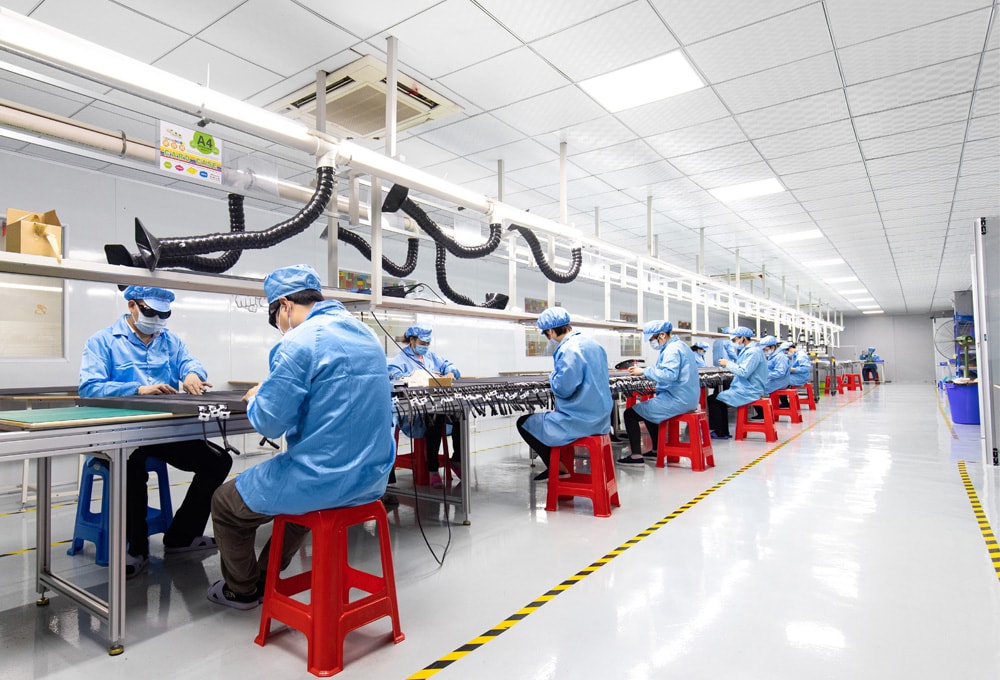
Your Leading LED Baseball Field Lights Manufacturer and Supplier
RC Lighting committed to providing quality LED baseball field light fixtures that meet all your needs.
- Low MOQ Requirement
- Customization Capability
- UL/ETL, CE, RoHS
- 5 Year Warranty
Baseball Field Lights FAQ
Stadiums and sports fields use customized Floodlights. Floodlights have a wide beam angle which casts the light on a broader and larger area. These LED lights consume lesser power and result in high levels of illumination.
In a baseball field, the lumen requirements for infield and outfield areas are different. Infield requires higher brightness than outfield because all the action takes place inside the infield. For all game levels, the lumen requirement has been summarized as follows:
- Recreational/training Game: Infield (792624 lm), Outfield (8823477 lm)
- Amateur Game: Infield (1321040 lm), Outfield (13235216 lm)
- General Game: Infield (2642079 lm), Outfield (30882170 lm)
- Professional Televised Game: Infield (3963119 lm), Outfield (44117386 lm)
Standard heights should be implemented to reduce glare and create proper illumination. The baseball light fixtures (A, B, and C, as shown in fig.) are of different heights. The A-fixtures illuminate infielders and pitchers. B-fixtures highlight both infield and outfield. C-fixtures are for outfield illumination.

General rules for different baseball gameplays are:
- 12-15 meters for recreational baseball games.
- 15-40 meters for college-level games.
- 25-60 meters for international televised games.
There are three pole placement standards, 4, 6, and 8-pole layout. For smaller fields, 4 and 6 lighting poles are used whereas. An 8-pole setup is used for high-level international games. Out of these poles, two poles are allotted to the infield illumination.
If you use 50000W LEDs to light up a baseball stadium, then the average monthly electricity bills will be as follows:
50000 x $0.12/1000 x 8 hrs x 30 days = $1440.
This is ten times less than the cost resulting from traditional halogen lights. So, choose wisely!
One reason can be the loose wiring of the bulb and the fixture. Sometimes bulbs and fixtures are incompatible, and it causes buzzing.
Another cause can be a defective lamp. To avoid buzzing, install carefully and make sure both the lamps and fixtures are from the same manufacturer.
Compared to halogen bulbs, LEDs don’t often buzz and function smoothly.
Floodlights are heavy-duty lights that used to light up extensive stadiums. They have a wide beam angle (up to 120°) and consume lesser wattages than spotlights.
On the other hand, spotlights have smaller beam angles (<45°) and light up smaller areas and spots. As a result, the output light is concentrated and can be controlled easily.
Metal halides are arc lamps that use vaporized salts to produce heat inside the tube. The intense heat generated results in light energy. This process takes up 5-20 minutes, called ‘warm-up’ time to reach 90% output intensity.
LEDs, on the other hand, reach the maximum light output in a matter of seconds.
Get Started With RC Lighting Today!
Send us an inquiry for your requirements, and we will get back to you shortly.
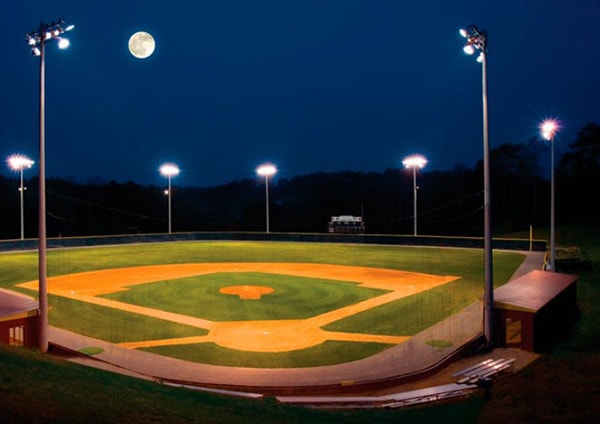
How to Buy LED Baseball Field Lights – A Complete Buyer’s Guide
Lighting a baseball field, like any large lighting project, is a massive undertaking. Depending on the location of the field, its size, and whether it is meant for Little League or Major League play, each field has its own set of standards. Because baseball involves a tiny object traveling at high speed, the LED Baseball field lights must be far more intense than, say, lighting for a soccer pitch.
Table of Contents
What Are LED Baseball Field Lights?
LED baseball field lights are fixtures used for baseball/softball field lighting. They can brighten up an entire field while distributing light evenly. Baseball is one of the most popular and widely played sports in the world. A baseball diamond, often known as a sandlot, is a field where baseball is played. Regardless of the level of play, baseball field lighting must ensure that every region of the field is evenly lit and that no light fixtures interfere with the game’s play.
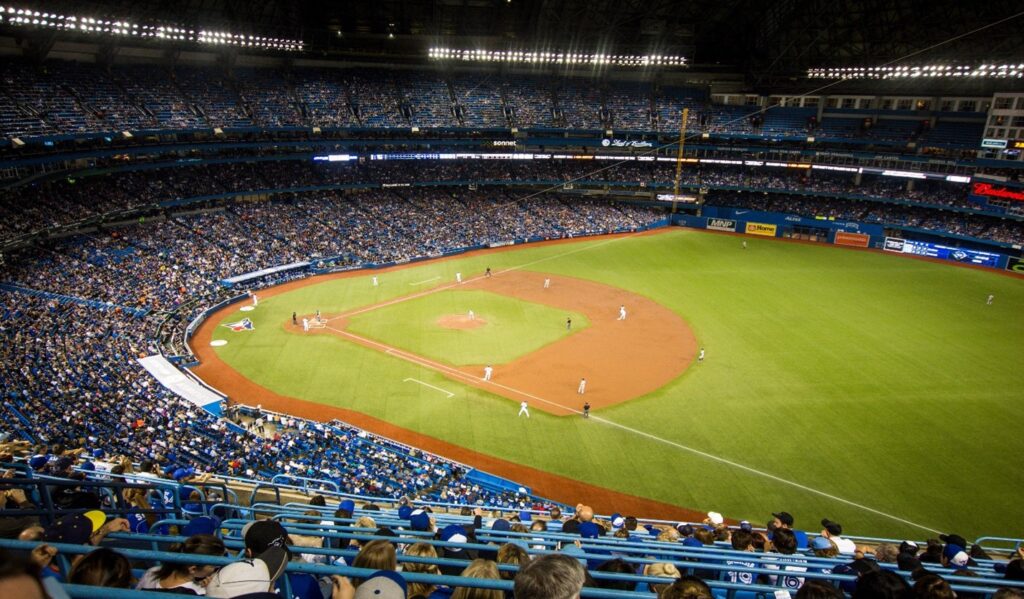
Furthermore, LED lights are cost-effective, saving up to 80% of energy. LED lights have a low to nil maintenance cost. This is because LED lights have a longer life span. Here we are, with everything you need to know about LED baseball field lights.
What Are The Benefits Of LED Baseball Field Lights?
Lighting is one of the most critical components of a baseball field. LED baseball field lights, without a doubt, play an essential role in gameplay. For both players and spectators, this style of illumination improves visibility. In addition, it has a direct impact on the players’ performance. Following are the benefits of using these lights.
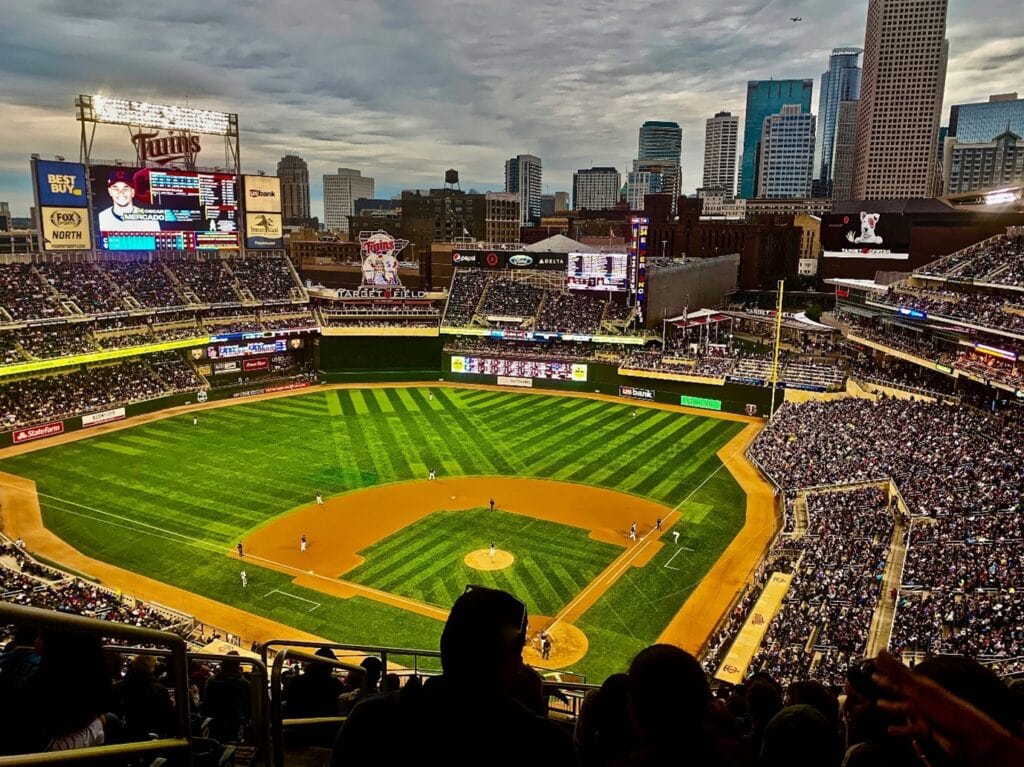
1. Environment-Friendly LED Baseball Field Lights
LED lights do not emit UV rays, and only around 5% of the electricity they generate is converted to heat. This means they don’t produce a lot of heat and, as such, are organic and green-friendly. Nowadays, another environmentally safe factor is the inclusion of heat sinks in LED light fixtures. These sinks prevent overheating and allow the lights to survive a wide range of temperatures and weather conditions.
2. Better For Broadcasting
Broadcasting in LED lighting for baseball stadiums is heaps better than using the alternative metal halide lights. LED lights turn on quicker, are adjustable, etc., required during filming, whereas the metal halide lights are much slower to even reach maximum brightness!
Televised games are often recorded live in high quality, and since LED lights have minute flickering, slow-motion replays are much easier to broadcast.
3. Energy Savings By LED Lights
LED baseball field lights to make sure that they don’t cost you a large amount of money and save you about 70% of energy.
4. Longer Life Expectancy
They have longer life spans of approximately 10-40 years.
5. Improved Illumination On The Baseball Field
LED stadium lights provide the audience with the best view from every side of the stadium, and also players can play without any difficulty.
6. Horizontal And Vertical Illumination
Because the baseball is minor, moves quickly, and changes in trajectory are challenging to catch, sufficient horizontal and vertical illumination over a specified height range is required.
7. Compatibility With The Gradient Connection
It is compatible with the uniformity and gradient connection to meet the lighting
8. No Light Pollution, High Uniformity
Uneven field brightness will influence the line of sight, affecting both the player’s performance and the audience’s enjoyment. Therefore, LED baseball field lights are fitted with Secondary Optical Aluminum reflective cups and lenses for the best results and to eliminate light pollution.
The high-quality products come with a 10-year parts warranty and a 28-year lifespan with an average runtime of 8 hours per day. Their durability promises that maintenance won’t be a problem for a long time. To light a regular baseball field, the total cost ranges from $120,000 to $200,000 if purchased in the United States or Europe, yet it is just $40,000 to $90,000 in China.
Why Do You Need To Upgrade Lights To LED Baseball Field Lights?
1. Life Expectancy
LED lights have an average life expectancy of 80,000 hours; hence they can run for a long time. This proves advantageous since it decreases maintenance costs in the long run. However, metal halide lamps are also significantly less safe for people and the environment than LED lights.
2. Power Ranges
Metal halide lights have an average power ranging from 400 to 1500 watts, with 1500-watt lights being used on most baseball fields due to the need for high-intensity lighting. Still, metal halides have a slow turn-on time of about 30 minutes to reach maximum brightness. Metal halide lights also become extremely hot and require a long time to return to normal temperature. LED baseball field lights come in various ranges, ranging from 100 watts to 600 watts.
3. Time Saving Ability
If the electricity to a metal halide light is ever unplugged, it will immediately shut down and take anywhere from five to ten minutes to resume.
4. The LED Stadium Lighting Era Has Begun
One disadvantage of metal halide lighting is that as the lamps age, their color begins to shift. Individual lights will start to change at different periods, resulting in a slightly different appearance over time. Unfortunately, a small amount of mercury is vital to many metal halide lights. Thus, it makes them harmful to the environment.
5. Pollution Free Environment
Finally, metal halide lights emit ultraviolet radiation, which can cause disease if inhaled. While many stadiums still utilize metal halide lights, contractors are beginning to move to 500-watt LED lights to replace 1500-watt metal halide lighting.
The explanation for the change is simple calculations. A halogen-based 500-watt baseball stadium light will cost you around $40, while a 500-watt LED baseball field light would set you back around $400. The reason for this is that halogen lumens are ten times lower than LED lumens. What does this mean? It means that ten times more halogen lights will be required to match the intensity of LED lights.
How To Choose LED Baseball Field Lights?
LED baseball field lights are heavy-duty fixtures that must fulfill specific requirements such as strength, durability, beam angles, lumens, flicker-free, weather-proof characteristics, and much more. So let’s have a look at these points.
1. Anti-Glare
Glare can easily disrupt the whole game by disturbing the view of the players and causing confusion during the gameplay. Baseball itself is a small object which is the field must be optimally lit.
Glare depends on the position of the light. The fixture must throw light directly down to the field. A slight miscalculation in angles and placement can cause a problem. Moreover, diffusers are installed in the LEDs to reduce glare.
2. Color temperature and CRI
According to baseball lighting standards, the minimum color temperature of 5700K is preferred for pro-baseball and international games. Daylight is mimicked for such high-level gameplays. A CRI of 65+ is acceptable for baseball field lighting. The higher CRI, the better.
For broadcasting purposes, a better measure is TLCI which gives a more quality rating. TLCI (Television Lighting Consistency Index) of 90+ is best for broadcasted matches.
Level | Color temperature preferred |
Recreational/training | 3000K |
High school/college | 5000K |
Professional televised games | 6000K |
3. Beam Angles
Beam angles are deemed crucial in stadium lighting. Therefore, a general rule is higher the pole, the smaller the beam angle, and vice versa.
For long-range baseball field lights, 15-45° is optimum, whereas, for short-range infield lights, 60-90° is preferred.
4. Brightness and Lumens
The brightness varies with multiple variables, the area of the field being an essential variable. For example, the infield requires a higher illumination level than the outfield as all the action takes place inside where a referee is standing.
The major league baseball field is larger and requires 1500lx in infield and 1000lx in the outfield. Whereas for regular minor fields, the infield light should be a minimum of 538lx, and the outfield light should be 322lx.
The table below shows the standards set for every level of the field. These are not hard and fast rules and can be altered as per preferences and on-site variables.
Field Level | Infield(lx) | Outfield(lx) |
Recreational | 300 | 200 |
Amateur | 500 | 300 |
General | 1000 | 700 |
Professional | 1500 | 1000 |
The lighting level in footcandles according to standards:
Type | Target Light Levels | Max/min Uniformity Ratio |
Baseball/softball field | 50 fc (Infield) 30 fc (Outfield) | 2:1 (Infield) 2.5:1 (Outfield) |
5. Light Uniformity
Lighting uniformity means how uniforms and homogenous the illumination is in the field. To measure this, the field area and the lux rate is calculated. Lux number increases where the light spread overlaps. For fields with higher lux levels (international games), the light uniformity ranges between 0.6 and 0.7. For high school and smaller leagues, 0.5 to 0.6 is best suited. For smaller training fields, the number is rated at 0.4 to 0.6.
6. Flicker-free
When a game is being broadcasted, there is a high chance of the camera not capturing the shots played. Therefore, 4K high cameras must be used, and the lighting should be flicker-free to capture a smooth play.
Flicker is usually a problem in metal halides, and ballast controls reduce the flicker rate in these lamps. However, in LEDs, flickering is already very low due to high flash pulses.
7. Wattage
Baseball and softball field lights’ wattage are mainly 400W, 1000W, 1500W, and 2000W. As the field area and gameplay level increase, higher wattage lamps are used.
8. Number of Fixtures Required
The number of lighting poles depends on the field area and level of play. There are mainly 4, 6, and 8 pole setups, as shown in the figure. A minimum of 2 poles are allotted for the infield, and 4/6 poles are placed across the outfield.
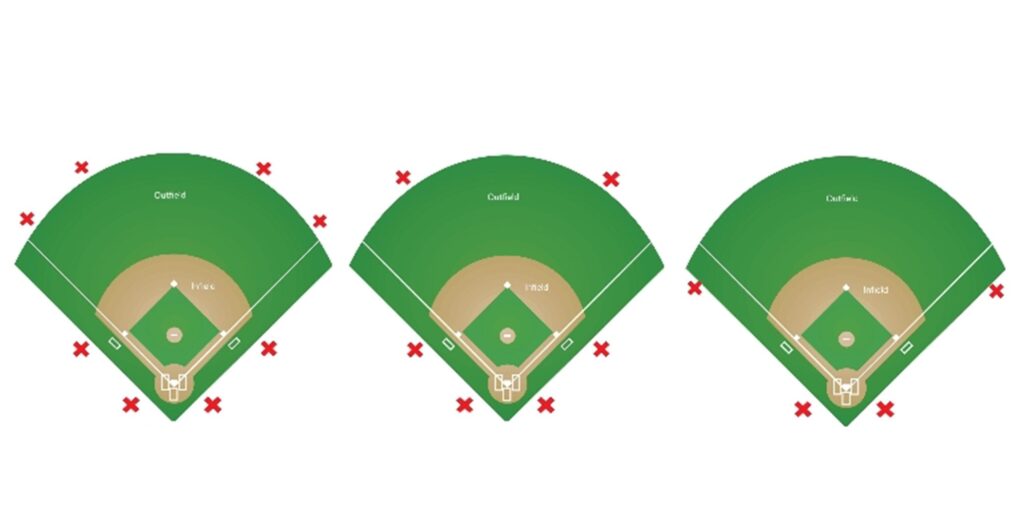
A 4-pole setup is best for smaller fields with a ballfield radius close to 200-250 feet. Any field larger than that will require a 6 or 8 pole setup. The major league always uses eight pole layout.
9. Fixture Poles Placement
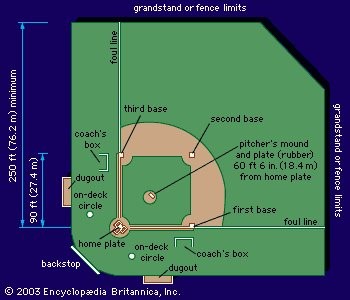
The lighting follows a strict placement design. This is the job of a lighting engineer as he designs the placement according to the field characteristics. The poles are placed at the perimeter of the outfield.
- Two poles illuminate the infield. These are placed behind the home plate.
- The third and fourth poles are estimated 140-170 feet distance from the origin of the field radius.
- In the 6 and 8-pole layout, the rest of the poles are placed at the parameters of the outfield, as shown in the figure below.
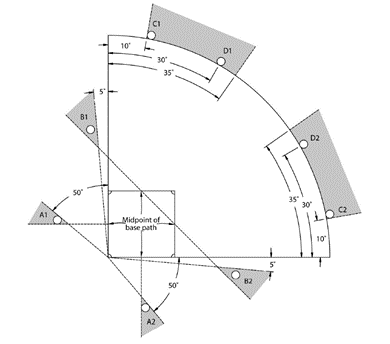
10. Pole Height
The lighting poles eight vary with the field area and level of play. However, a general standard for each field is explained below:
- For recreational fields and little league baseball games, a height of 12-15 meters is usually preferred. Such applications don’t require a very high-standard lighting design. The height mentioned is cost-effective and is optimal for casual games.
- For high school and college games, the height increases to 15-40 meters.
- For televised international games such as MLB National, the highest standards are implemented, and 25-60 meter height is preferred.
11. Material and IP-Rating
Since field lighting fixtures face all kinds of weather changes and corrosive pollutants in the environment, they must be made with high-strength materials such as galvanized steel, stainless steel, and aluminum. In addition, wiring must be enveloped in conduits and covers.
All components must be UL-listed and meet NFPA 780 standards for safe functioning.
LED baseball lights must have a rating of IP65 or IP66.
12. Lighting Control and Sensors
It is a desirable feature and can save a lot of power and money in the long run. Moreover, owners can schedule the on/off timing of these lights fixtures hence saving electricity efficiently.
13. Cost of Electricity
LEDs can easily save you about 70% of electricity compared to traditional halogen or halide lamps. Here’s a rough calculation.
If you want to light up a baseball field using a 30,000 W bulb, the daily cost will be; 30,000×0.12/1000x 8hrs= $28.8. This amounts to $864 monthly.
On the other hand, for equivalent light output, in the case of a halogen bulb, you need a 300,000 W lamp; 300,000×0.12/1000×8= $288. So monthly charges will roughly amount to a whopping $8640!
You can now decide what is best for your baseball field.
Conclusion
As a result, baseball field illumination plays a critical role in player performance and safety. This is why it needs to be meticulously prepared. A proper lighting design must take into account the LED baseball field lights’ full capability. Therefore, we provide you with the best of the lot based on all known details and professional acknowledgment, such as brightness levels, uniformity standards, pole location, and height, led sports lights selection, and, most importantly, the most cost-effective option.
RC Lighting is here to assist you if you still have an issue. Our team of lighting professionals is always available to assist you in adequately designing, purchasing, and installing lights

